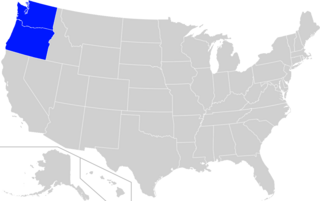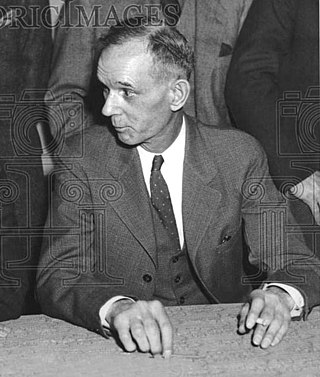
Walla Walla University is a private Adventist university in College Place, Washington. The university has five campuses throughout the Pacific Northwest. It was founded in 1892 and is affiliated with the Seventh-day Adventist Church.

The Northwest Conference (NWC) is an intercollegiate athletic conference which competes in the NCAA's Division III. Member teams are located in the states of Oregon and Washington. It was known as the Pacific Northwest Conference from 1926 to 1984.

The Cascade Collegiate Conference is a college athletic conference affiliated with the National Association of Intercollegiate Athletics (NAIA). Member schools are located in the Northwestern United States and in British Columbia. The conference's members compete in 15 sports. The current commissioner of the conference is Robert Cashell.

The Gonzaga Bulldogs, also known unofficially as the Zags, are the intercollegiate athletic teams representing Gonzaga University, located in Spokane, Washington, United States. Gonzaga competes in the National Collegiate Athletic Association (NCAA) Division I as a member of the West Coast Conference.

The Pacific Coast Conference (PCC) was a collegiate athletic conference in the United States which existed from 1915 to 1959. Though the Pac-12 Conference claims the PCC's history as part of its own, with eight of the ten PCC members in the Pac-12 for many years, the older league had a completely different charter and was disbanded in 1959 due to a major crisis and scandal.

The Washington State Cougars are the athletic teams that represent Washington State University. Located in Pullman, Washington, WSU is a member of the Pac-12 Conference in NCAA Division I. The athletic program comprises ten women's sports and seven men's intercollegiate sports, and also offers various intramural sports.

Clarence Sinclair "Hec" Edmundson was an American basketball and track coach.

Robert Gilmour Dobie was an American college football player and coach. Over a period of 33 years, he served as the head football coach at North Dakota Agricultural College (1906–1907), the University of Washington (1908–1916), the United States Naval Academy (1917–1919), Cornell University (1920–1935), and Boston College (1936–1938), compiling a career college football head coaching record of 182–45–15 (.783).
The Northwest Athletic Conference (NWAC), formerly the Northwest Athletic Association of Community Colleges (NWAACC), is a sports association for community colleges in the U.S. states of Oregon, Washington, and along with the Canadian province of British Columbia.

The Oregon State Beavers football team represents Oregon State University in NCAA Division I FBS college football. The team first fielded an organized football team in 1893 and is a member of the Pac-12 Conference.
The 1911 Oregon Webfoots football team represented the University of Oregon as a member of the Northwest Conference during the 1911 college football season. Led by second-year head coach Bill Warner, the Webfoots compiled an overall record of 3–2 with a mark of 2–1 in conference play, tying for second place in the Northwest Conference. Oregon played home games at Kincaid Field in Eugene, Oregon.
The 1912 Oregon Webfoots football team represented the University of Oregon as a member of the Northwest Conference during the 1912 college football season. Led by Louis Pinkham, in his first and only season as head coach, the Webfoord compiled an overall record of 3–4 with a mark of 2–3 in conference play, tying for fourth place in the Northwest Conference. The team played home games at Kincaid Field in Eugene, Oregon.
The 1902 Washington football team was an American football team that represented the University of Washington as a member of the Northwest Intercollegiate Athletic Association (NIAA) during the 1902 college football season. In its first season under coach James Knight, the team compiled a 5–1 record. Fred McElmon was the team captain.
The 1917 Washington football team was an American football team that represented the University of Washington as a member of the Northwest Conference and the Pacific Coast Conference (PCC) during the 1917 college football season. In its first season under coach Claude J. Hunt, the team compiled an overall record of 1–2–1 and was outscored by its opponents by a combined total of 47 to 14. Washington had a record of 1–1–1 in Northwest Conference play, placing third, and 0–2–1 against PCC opponents, finishing last out of five teams. Ernest Murphy was the team captain.
The Northwest Conference, also known as the Northwest Intercollegiate Association, the Northwest Intercollegiate Conference, the Pacific Northwest Conference, and the Pacific Northwest Intercollegiate Conference, was a collegiate athletic conference with member schools located in the Pacific Northwest of the United States.
The Evergreen Conference (EvCo), known as the Tri-Normal League from 1920 to 1938 and the Washington Intercollegiate Conference (WINCO) from 1938 to 1947, was an intercollegiate athletic conference composed of member schools located in the states of Idaho, Oregon, and Washington and, for a time, the Canadian province of British Columbia. The league existed from 1938 to 1984. Most of the conference's members subsequently joined the Columbia Football Association.
The 1912 Oregon Agricultural Aggies football team represented Oregon Agricultural College (OAC)—now known as Oregon State University—as a member of the Northwest Conference during the 1912 college football season. In their second and final season under head coach Sam Dolan, the Aggies compiled an overall record of 3–4 record with a mark of 1–3 against conference opponents, placing last out of six teams in the Northwest Conference, and outscored their opponents by a combined total of 57 to 40. Otto Sitton was the team captain.
The 1946 Northwest Conference football season was the season of college football played by the seven member schools of the Northwest Conference (NWC) as part of the 1946 college football season.
The 1921 Whitman Fighting Missionaries football team represented Whitman College as a member of the Northwest Conference during the 1921 college football season. Led by sixth-year head coach Vincent Borleske, the Fighting Missionaries compiled an overall record of 4–2 with a mark of 3–0 in conference play, winning the Northwest Conference. Ben Comrada, a graduate of Ballard High School in Seattle, played at tackle and was the team captain. Whitman played home games at Ankeny Field in Walla Walla, Washington.

The Western Washington Inter-Collegiate Athletic Association (WWIAA) was an early athletic conference governing competition between member institutions in Western Washington on the Puget Sound.










